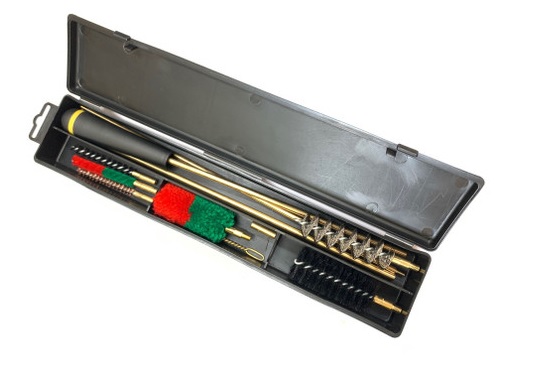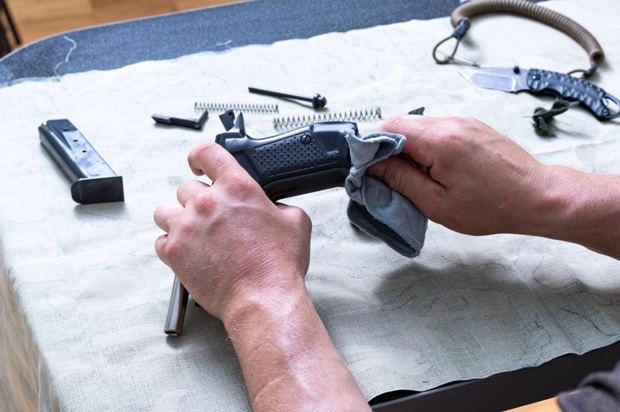What a Good Gun Cleaning Kit Needs (Make Sure You Check)
Jan 22nd 2025
Not all gun cleaning kits are created equal. Before you shell out good money on a kit (rather than buying all the components separately and assembling your own kit) make sure the one you have your eye on contains the following cleaning tools and essentials, at minimum.
A Cleaning Rod
Generally speaking, gun cleaning kits are either sold as rifle or pistol cleaning kits, and some are specialized as shotgun cleaning kits (these require special jag adapters to accommodate shotgun-gauge jags and brushes.
However, some all-in-one cleaning kits contain everything you need for a wide range of calibers, both for handguns and long arms.
Either way, any good gun cleaning kit needs at least one cleaning rod. If it is a kit for both handguns and rifles, a 3-piece rod is ideal because the rod can be used for handguns, unassembled, or put together for rifles and shotguns.
Slotted Jags
Slotted jags are specialized rod-end parts that are designed to hold a cleaning patch. These jags are necessary for running soaked (and dry) patches through the bore, for the purpose of dissolving and scrubbing away powder and bullet jacket fouling. Without a slotted jag it’s harder to use cleaning patches, so any good gun cleaning kit should have some. Fortunately, most slotted jags can be used with a variety of different calibers, so the kit won’t need to have too many.
Cleaning Jags
Some cleaning jags are not slotted, and instead have a solid tip that is used to nearly fit the diameter of the bore, in order to force a patch through it. These can be used in concert with, or after slotted jags, in order to remove fouling from the bore.
Bronze Brushes
Bronze cleaning brushes are used for scrubbing fouling out of a gun’s bore when a patch and solvent alone won’t get the job done. They are stiffer and more robust and abrasive than cleaning patches, which makes them ideal for the job.
Unlike slotted jags, bronze cleaning brushes must correspond closely to the bore of the gun, and as a result bore brushes are either bore or bore class specific, for instance, 12 or 20 gauge, or .30 caliber-class.
Worked through the barrel from the breech to the muzzle, especially after an appropriately solvent has been applied, the brush will scrub fouling loose so that it can then be removed by a patch or a mop. Brushes are especially useful for cleaning rifles, as they are designed to dig into the rifling’s grooves and dislodge trapped fouling.
Patches
Patches are small, paper-like pieces of cotton (or another similar material) that are used to apply solvent to the bore, as well as to absorb and remove fouling and excess cleaning products such as solvent, oil or grease.
Patches can actually be made by tearing up pieces of old cotton rags, but all the same, they are indispensable and highly affordable, so any quality gun cleaning kit should have a bunch.
Powder Fouling Solvent
Powder fouling solvents, like Hoppe’s No. 9, are designed to dissolve powder fouling and tar that can accumulate in the bore of a gun, in the action, and in other areas that get blasted by the pressurized gases generated during firing.
Modern powder fouling is not corrosive the way old-school black powder and substitutes are, but a heavily fouled bore will not be as accurate as one that is kept clean. As a result, any quality gun cleaning kit will have a good powder solvent in its contents.
Copper/Lead Solvent or Bore Cleaner
If you’re shooting copper-jacketed bullets, over time, copper fouling, which is a bluish-green deposit, will accumulate in the barrel. If you shoot naked, lead nose bullets, lead fouling will accumulate. Both are detrimental and should be removed.
For one, lead fouling is toxic. Even if that were not the case, when the bore gets obstructed by excess lead and copper fouling, the ballistic dynamics shift and the gun will not shoot as accurately as it would if it were clean.
On top of that, regular powder solvents often will not dissolve or remove lead and copper fouling, so make sure you get a kit that contains them.
Lubricant (Gun Oil)
A gun cleaning kit should contain a lubricant, such as Rem Oil, for two very important reasons.
One is that gun lubricants reduce friction on moving parts, preventing heat-related damage and wear as a result of friction.
The other is that a good gun oil basically seals the surface of the treated part, thereby helping to protect it against corrosion.
While it is not a cleaning product so much as a maintenance item, any good gun cleaning kit should still contain some sort of quality lubricant.
Other Things That Are Nice to Have

While this post has already covered the essential items that should be contained in a gun cleaning kit, there are some others that are nice to have. Among these are:
- Cleaning mops, which are reusable and can be used in lieu of patches to clean the bore of excess fouling and oil.
- Grease, which is preferable in some instances to oil. Oil can migrate but grease usually stays put and offers all of the other benefits of oil.
- A cleaning pad, where you can lay your gun and disassembled components for cleaning.
- A vise, in which you can rest your gun while partially disassembled for cleaning.
- Nylon brushes, which are not as abrasive as bronze or brass, which can be used on sensitive surfaces like wood or plastic.
- Brass brushes, which are softer than steel and which can be used on steel (and in some cases, aluminum) without the risk of scratching them.
- A case, in which you can organize and store all of the constituent components of the gun cleaning kit.
Any gun cleaning kit that contains all of the items mentioned here should be more than enough to get you started.

SARCO Has Your Next Gun Cleaning Kit
If you’re here for a gun cleaning kit, check out our collection via the previous link and get in touch with us at 610-250-3960 if you need help or have any questions.

